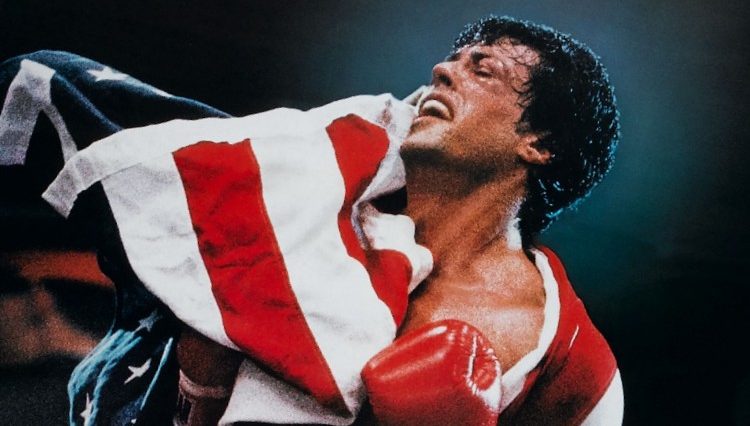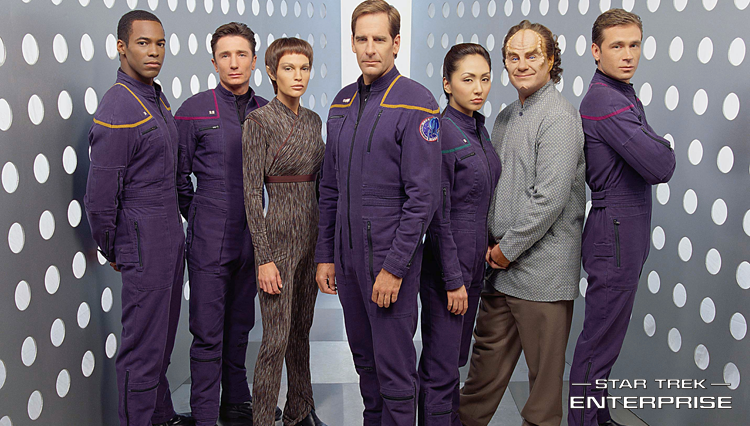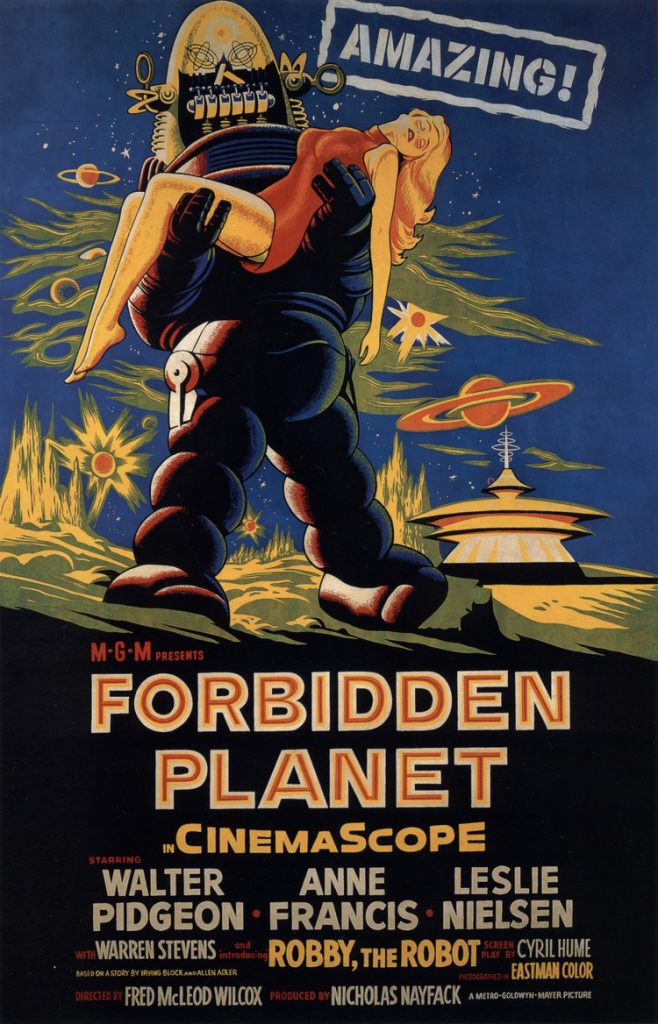
Being hailed as “first” in any endeavor is not always to be, at least academically, held up as a standard. “First” and “Standard” are loaded words and bring automatic ideas of respect where only acknowledgment would (or should) be considered. Just because something is first doesn’t make it best. Ideas can be improved upon. Forbidden Planet started playing on Netflix a few weeks back, and I thought we should take a look at it for our Sunday dinner movie. I hadn’t looked at Forbidden Planet possibly in decades, so this was my first opportunity to see the movie on a big screen in high definition. Forbidden Planet is a movie swimming in “firsts.” First big-budget science fiction movie. First widescreen (Cinemascope) science fiction movie. First “mini-skirt” in a movie. First robot to get a screen and movie poster credit. It goes on.
The mini-skirt is interesting. The garment is connected to the gorgeous visage of Anne Francis. As iconic a presence in the movie as Robby the Robot, the camera loves Anne Francis and she is, I suspect, responsible for the project being green-lit in the first place. As Leslie Nielsen himself says in Naked Gun 2 1/2: The Smell of Fear, “She was the kind of woman who made you want to drop to your knees and thank God you were a man!” Without her, the movie is a sausage fest, and I doubt any self-respecting leering studio executive would ever drop such serious coin on a risky venture. If you Google “Anne Francis Forbidden Planet,” you will be inundated with hundreds of “cheesecake” shots of Francis with Robby the Robot. This was par for the course in the Hollywood studio system of the time.
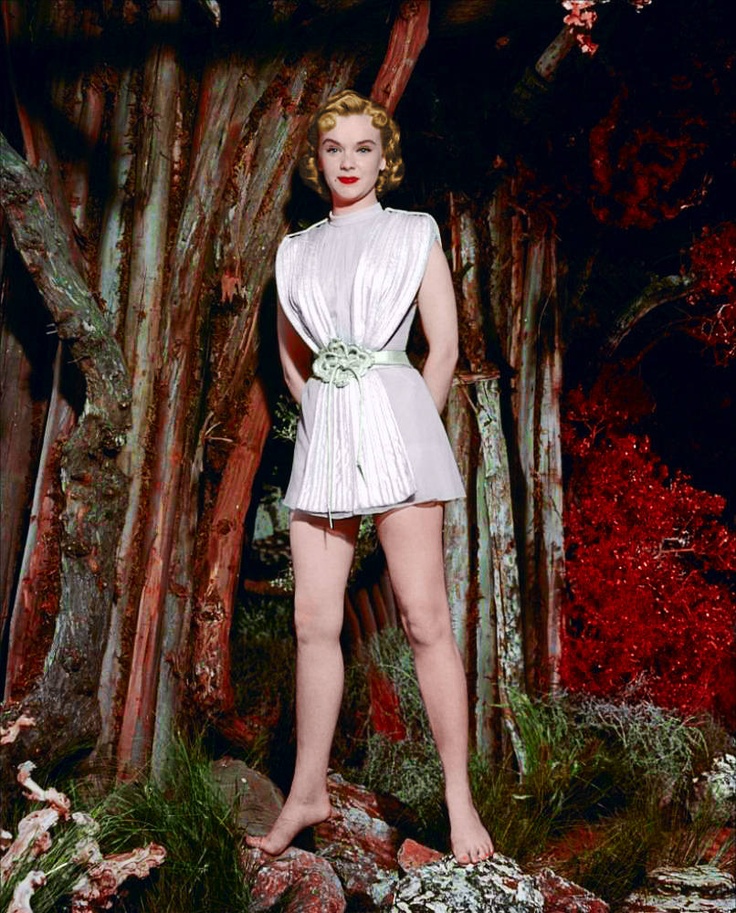
It was not unheard of, nor was it ridiculed to have glamour (read: “arty”) shots of your scantily-clad leading lady headlining a production; ostensibly this is a big reason beautiful people (women, specifically) are cast in movies destined for the big screen and why most of us demand the escape of going to the movies. The way the camera lingers on her perfect body and delicate fawn-like features — it’s positively lewd, but she is required to compensate for the lack of other females in the cast. I can understand why women find this treatment irritating or, at the very least, insulting, but I also find, as a man (and as I grow older) I’d rather be prized for my “beauty” and youthful appeal than my intellect. That’s just human vanity. We don’t want to plunk down near-20 bucks a head to watch ugly people engaged in rudimentary tasks. We want to watch a beautiful woman menaced by the monsters of the Id, or something like that. This is a movie that turns unexpectedly heavy and dark.
John J. Adams (Leslie Nielsen) commands the C 57-D starship on a mission of exploration to the planet Altair IV. Up until recently, the planet had been the subject of an expedition, but the regular reports stopped and, despite warnings from a Dr. Morbius (Walter Pidgeon) to stay away, Adams orders his crew to land the ship on the mysterious planet. In short order, they are introduced to Morbius’ beautiful daughter, Altaira (I guess she’s one of those kids named after where she was conceived like Bryce Dallas Howard) and Robby the Robot (who looks like an ice cream machine come to life). They are taken to Morbius’ shielded compound, giving the production design team a chance to shine.
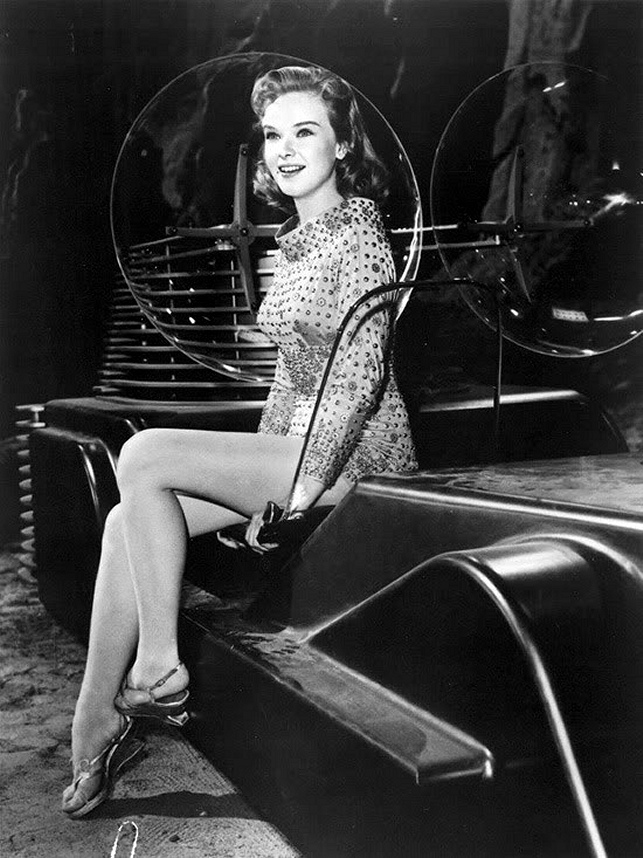
Compared to previous science fiction films, Forbidden Planet is a significant leap ahead in terms of cinematography, costumes, art direction, and the Oscar™-nominated visual effects. Sets and properties were custom-built. The C 57-D’s command center is a modular working area that would influence similar sets. Morbius’ home is located in the center of an oasis complete with crops and a cozy swimming hole where Altaira enjoys skinny-dipping. Morbius takes Adams to his laboratory filled with pieces of technology innovated by the Krell, the long-dead race of extraterrestrial titans who once ruled not only Altair IV, but the space around it. There are underground chasms and a vital (and dangerous) power system. Because of this technology (matched with his intellect) he can summon creatures, great and small. He can control the weather. He and his daughter can live in virtual, if isolated, peace. Lately, and coinciding with the arrival of the C 57-D, the creatures have turned. They’ve become violent. An enormous (and conveniently invisible) monster ransacks the ship and threatens the crew.
It doesn’t take a psychologist to see that Morbius doesn’t have both oars in the water. He’s not playing with a full deck. He’s a couple sandwiches short of a picnic. He’s a full-blown whack-a-loon! Megalomania and unchecked power make for uncomfortable bedfellows. Morbius is obviously lashing out at the all-male crew for awakening in his daughter a burgeoning, thriving sexuality. Morbius has manifested his psychotic anger into the form of a beast — the beast of his Id! It’s fascinating stuff, but the writer (Cyril Hume, working from a story idea by Irving Block and Allen Adler), only brushes against the surface of a deeper psychological issue — that of lust and jealousy for his daughter.
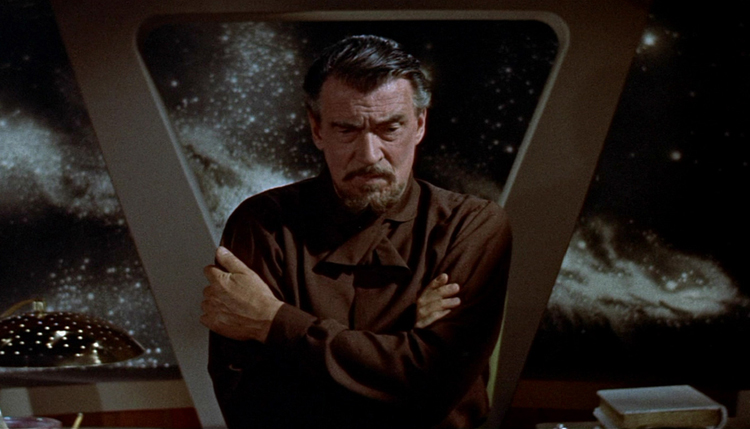
I keep thinking about Citizen Kane, Orson Welles’ 1941 opus; the default or easy “standard” by which all modern movies are made. Citizen Kane was the movie that launched a thousand film schools and brought film criticism into the pantheon of elite art theory. Citizen Kane was also a movie filled with firsts. Like Forbidden Planet, it barely turned a profit, but it was considered the textbook of a decent film education. I don’t know how true this is because I’ve seen at least a handful of films pre-dating Citizen Kane that employed the same techniques of camerawork and narrative, but didn’t receive the hype of Kane. Orson Welles was an egotistical loud-mouth who nearly sank his production by antagonizing William Randolph Hearst. Because of this, the movie received an enormous amount of negative publicity. Welles gives himself a perfunctory credit in the movie as the character, Kane, but his face and name appear prominently on posters and print ads. It’s a movie I can respect while also finding deadly dull. It’s not a movie you get a bunch of friends together to watch with pizza and beer.
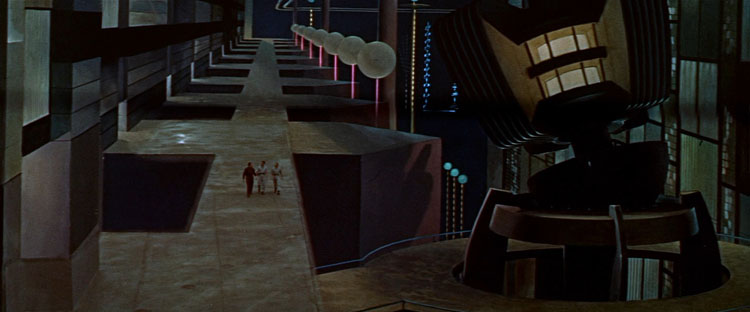
There are several silly character beats in Forbidden Planet exclusive to the time period in which the movie was made. We have the all-male crew, of course; horny men traveling through space, smitten with Altaira. Part-time alcoholic chef (Earl Holliman) turns Robby the Robot into a liquor manufacturing concern for some jarring comic relief. If people imbibed at the rate they’re depicted in movies, they would’ve been dead inside of a week, but we’re supposed to think a crew of dedicated professionals are capable of drinking each other under the table. When the men aren’t behaving like arrested adolescents, they’re attempting to seduce Altaira, and their advances are rather creepy.
Forbidden Planet is not nearly as boring as Kane, but it has a cheesy sensibility. There’s very little to separate it from the kinds of schlocky science fiction movies Mystery Science Theater 3000 lampooned for ten years. The acting is very big; loud, deep voices shouting, exaggerated mannerisms and gestures, technicolor and bright lighting, and the limitations of a studio set. I thought the movie would have been vastly improved if it were shot on location, but very few studio films of the time were shot outdoors because of the costs involved. Watching the movie these days, it’s shocking to me how much Star Trek copied its costumes, sets, and story. Virtually everything about Forbidden Planet was used in Star Trek, more so than Star Wars.
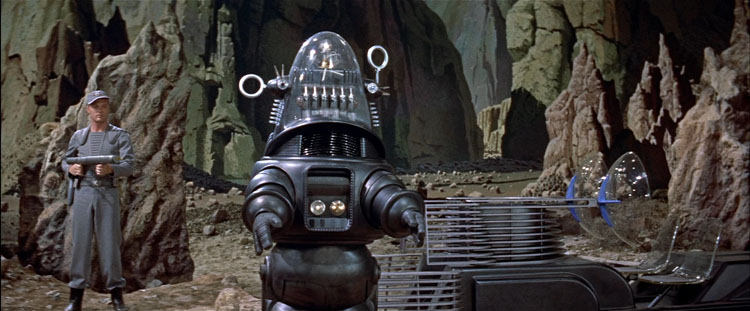
Star Wars owes more to the pulp adventure of Flash Gordon and Buck Rogers than the Shakespearean allusions of Forbidden Planet. We see variations on themes down the line of modern cinema. More money is spent. Improvements in visual effects, sound, and cinematography are made. Forbidden Planet was considered a risk for investors in 1956 when costume melodramas and cheap comedies were all the rage. Sixty years later, more money is spent producing movies like Forbidden Planet than any other movie being made, for good or ill. Forbidden Planet is one of a few movies, I feel, that could benefit enormously from being re-made. We wouldn’t stop there, would we? No! Make it a billion-dollar franchise! A multi-story arc! That’s the problem with franchises. We never know when to stop.


